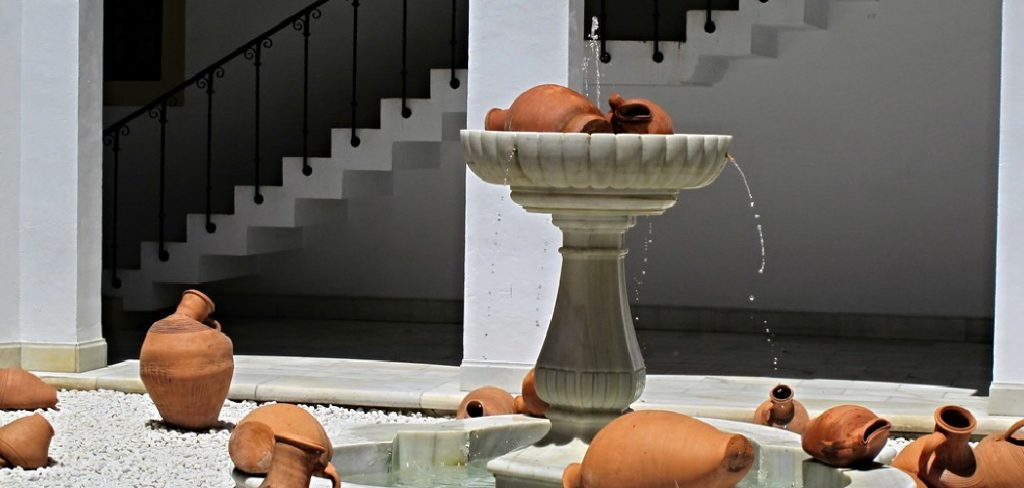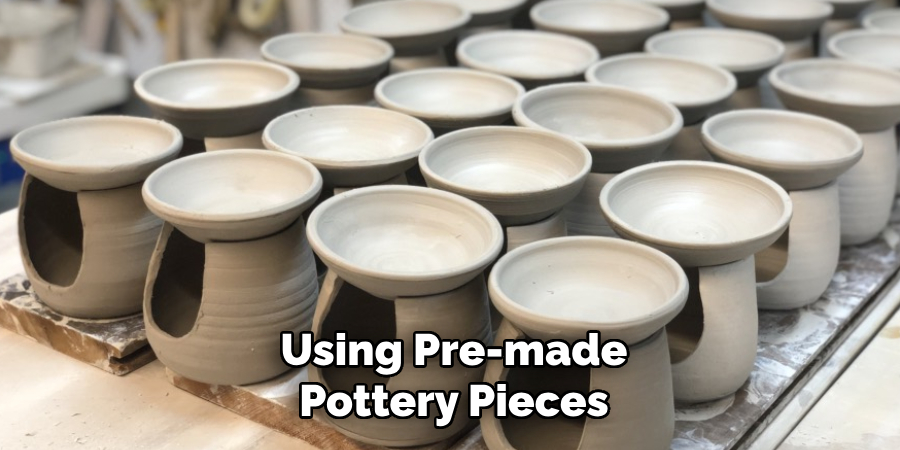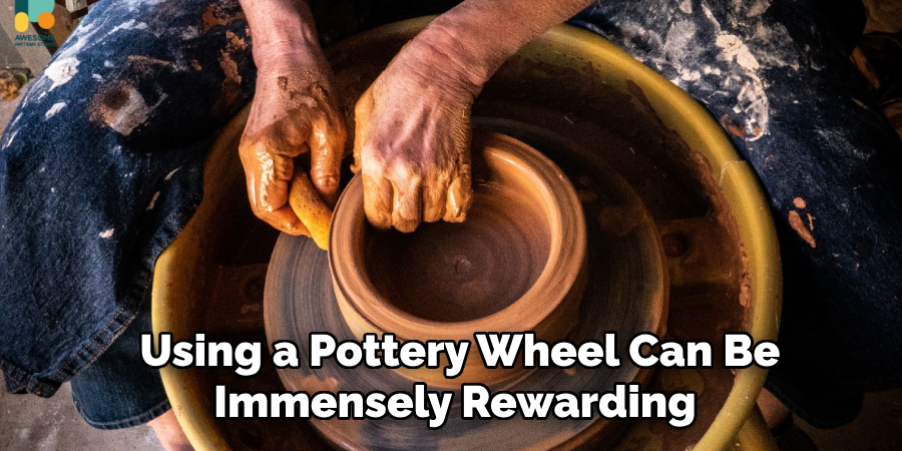Creating a pottery fountain is a wonderful way to introduce the calming sound of flowing water into your home or garden. This project merges the artistic elements of pottery with the peacefulness of a water feature, resulting in a unique piece that can elevate any setting. In this guide, we’ll cover the essential materials, tools, and steps needed to craft a pottery fountain, perfect for both beginners and seasoned crafters. Whether you’re looking to add a serene visual touch to your living space or an inviting centerpiece to your garden, a pottery fountain offers both beauty and tranquility.

What is a Pottery Fountain?
A pottery fountain blends the charm of handcrafted pottery with the calming sound of flowing water. These fountains typically feature a central ceramic or clay vessel where water gently cascades down its surface, creating a peaceful atmosphere. They come in various sizes and styles—from compact tabletop designs for indoor spaces to elaborate structures for outdoor gardens. The natural beauty of clay or ceramic offers a rustic yet sophisticated look, seamlessly fitting into diverse decor styles. Beyond their aesthetic appeal, the soothing water flow enhances tranquility and can humidify the air, enriching your living space.
Materials and Tools Needed for a Pottery Fountain
To create a pottery fountain, gathering the right materials and tools is crucial for a successful project. Here’s a list of what you’ll need:
Materials
- Ceramic or Clay Vessel: Choose a vessel based on your desired fountain size and design. This will be the central piece where water flows.
- Water Pump: A small submersible pump is necessary to circulate the water. Ensure it’s suitable for the fountain’s scale and water capacity.
- Tubing: Flexible clear or opaque tubing will connect the pump to the outlet where water emerges.
- Sealant: A waterproof sealant specifically for pottery or ceramics to prevent leaks and secure parts.
- Pebbles or Decorative Stones: These can be used to conceal the pump and add aesthetic appeal to your fountain base or around the vessel.
Tools
- Drill with Ceramic Bit: If your design involves drilling holes in the vessel for tubing, a drill with a ceramic bit is essential.
- Scissors or Blade: For cutting tubing to the desired length.
- Measuring Tape: To accurately measure distances for tubing and placement within your space.
- Sponge or Cloth: For cleaning and smoothing the vessel and materials before assembly.
Having these materials and tools on hand will set the foundation for constructing a beautiful and functional pottery fountain.
10 Methods How to Make a Pottery Fountain
In the world of home decor, a pottery fountain stands as a unique and captivating centerpiece. Whether you’re a seasoned DIY enthusiast, a home decorator looking to add a personal touch, or a gardener aiming to enhance your outdoor space, creating a pottery fountain is an enriching project. Not only does it bring a sense of tranquility with the soothing sounds of water, but it also allows you to flex your creative muscles. In this guide, we outline ten practical methods to make your own pottery fountain, each designed to cater to different skill levels and stylistic preferences.
1. Use Pre-Made Pottery Pieces
One of the simplest ways to create a pottery fountain is by using pre-made pottery pieces. Choose pots and bowls that complement your space, and stack them in a cascading style to allow water flow. Make sure to drill holes for tubing and adjust the water pump settings to control the flow rate. This method is perfect for beginners and those short on time.

2. Layered Terra Cotta Pots
Terra cotta pots are versatile and easily available. For this method, select pots of varying sizes. Drill holes in the center to accommodate a water tube, and stack them so the smallest pot is at the top. The layered effect naturally guides the water from one pot to the next. Terra cotta is porous, which helps in achieving a natural, aged look over time.
3. Mosaic Tile Fountain
Add a splash of color to your pottery fountain by incorporating mosaic tiles. Use waterproof adhesive to attach tiles onto your pottery pieces before assembling the fountain. This method offers a great opportunity to personalize your fountain with patterns and colors that resonate with your aesthetic. Mosaics are a vibrant way to make your fountain truly stand out.
4. Glazed Pottery for a Rustic Charm
For a more rustic and traditional look, consider using glazed pottery. The glossy finish enhances the visual appeal, especially in sunlight. You can easily find glazed pots in garden stores, or you could glaze them yourself if you’re feeling particularly crafty. The glaze not only adds beauty but also protects the pottery from water damage.
5. Bamboo and Pottery Combination
For those who appreciate an Asian-inspired aesthetic, combining bamboo with pottery can result in a striking design. Create a simple fountain using a large pottery basin at the base with bamboo spouts guiding the water. This method is both serene and sophisticated, perfect for a Zen garden or meditation space.
6. Incorporate Natural Stones
Enhance the natural beauty of your fountain by adding river rocks or pebbles. Place them at the base of the fountain or within the pottery pieces to create a harmonious blend with the flowing water. The stones will also help to stabilize the structure and create a gentle bubbling effect as water flows over them.
7. Solar-Powered Fountain
Make your pottery fountain eco-friendly by utilizing a solar-powered water pump. This is a great option for outdoor fountains, as it requires minimal wiring and is cost-effective in the long run. Ensure your fountain is placed in a sunny spot to maximize the pump’s efficiency.

8. Miniature Indoor Tabletop Fountain
If space is limited, consider crafting a miniature fountain for indoor use. Use small pottery bowls and a compact water pump to create a tabletop version. These fountains are ideal for adding a calming influence in workspaces or living areas and require less maintenance than larger outdoor models.
9. Multi-Tiered Amphora Design
Capture the elegance of classical design with a multi-tiered amphora-style fountain. Use amphora-shaped pottery that allows water to cascade gently from one level to the next. This design works well for both indoor and outdoor settings, adding a touch of timeless sophistication.
10. DIY Pottery Wheel Creations
For the truly adventurous, creating pottery pieces from scratch using a pottery wheel can be immensely rewarding. This method allows you to tailor every aspect of your fountain’s design, from size and shape to texture and finish. While it requires more skill, the result is a one-of-a-kind piece that reflects your personal style.

Maintenance and Upkeep
To keep your pottery fountain in top-notch condition, regular maintenance is key. Start by cleaning it regularly to avoid algae and mineral deposits, especially if it’s outdoors and exposed to the elements. Use mild cleansers suitable for pottery and soft brushes to prevent scratches or damage.
Check the water pump often to clean the filter and clear out any debris disrupting the water flow. Occasionally disassemble the fountain for a thorough clean and inspect each piece for wear or damage. If you live in a colder area, protect your fountain during winter by draining and covering it to prevent cracks from freezing temperatures. Also, keep an eye on the water level to ensure the pump stays submerged and doesn’t burn out.
By maintaining your pottery fountain, you’ll not only preserve its structure but also keep its beauty and soothing function intact.
Troubleshooting Common Issues
Uneven Water Flow
If the water flow is irregular or weak, first ensure the pump is operating smoothly. Clean the pump filter to remove any obstructions caused by debris or mineral buildup. It’s also important to check the water level; inadequate water can lead to inconsistent flow and potentially damage the pump.
Leaks in the Basin
If you spot leaks in your fountain, examine the pottery for cracks or chips. Small cracks can often be sealed using waterproof adhesive or silicone sealant to keep the fountain watertight. For bigger leaks, consider replacing the damaged piece to preserve the fountain’s structure.
Excessive Noise
A pottery fountain should emit a gentle, calming sound. If it becomes noisy, check that the pottery pieces are properly aligned and stable, as loose elements can vibrate and create noise. Additionally, ensure the pump is fully submerged; an exposed pump tends to operate louder.
Algae Growth
Algae not only spoils the fountain’s appearance but can also clog the system. To prevent this, place your fountain away from direct sunlight and regularly clean it with a non-toxic algae cleaner. Using distilled or treated water can further reduce algae growth.
Pump Not Working
If the pump stops working, inspect it for any visible signs of damage or electrical issues. Make sure the power source is active and connections are secure. If the problem persists, it may be time to replace the pump.

Conclusion
Creating a pottery fountain can be a rewarding endeavor that adds beauty and tranquility to any space, whether indoors or outdoors. By choosing from a variety of designs, such as mosaic embellishments or bamboo and pottery combinations, you can tailor your fountain to reflect your personal style and aesthetic preferences. Maintaining your fountain with regular cleaning, careful monitoring of the pump, and addressing any issues promptly will ensure its beauty and functionality for years to come.
Toby Rede is a professional potter focused on creating functional and artistic ceramics. His work blends natural textures with modern forms, often inspired by sustainable gardening and outdoor environments. Toby’s pottery emphasizes both utility and beauty, reflecting his philosophy of intentional craftsmanship. On the blog, he shares insights on integrating handmade objects into everyday life.
Education
- Associate Degree in Ceramic Technology, Alfred University
Professional Focus
- Pottery creation with a focus on functionality and artistic expression
- Techniques exploring texture, glazing, and sustainable materials
Professional Accomplishments
- Work featured in regional art shows and garden exhibitions
- Collaborations with local craft fairs and home decor shops

